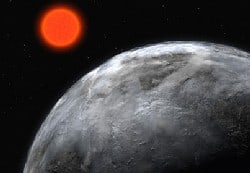By Matin Durrani

I’ve never done any astronomy but I imagine that looking for extrasolar planets must be fun. Given that researchers have so far discovered more than 400 of these distant beasts, tracking them down them can’t be all that hard, making the “reward/effort ratio” pretty high.
Of course, what we all want to know – from our puny, self-absorbed human perspective – is when will we spot the first truly Earth-like planet.
Well, a couple of weeks ago I was intrigued by a paper on arXiv by Samuel Arbesman from Harvard University and Gregory Laughlin from the University of California, Santa Cruz, who looked at the rate at which the first 370 extrasolar planets were discovered, did some jiggery-pokery in the form of a “bootstrap analysis”, and then worked out exactly when “the first potentially habitable planet with a mass similar to Earth” will be found.
The pair weren’t talking about vague dates in the future but had a very specific time in mind – with the likeliest date being, wait for it, “early May 2011”. Now that’s what I call having confidence in your data.
Today, though, astronomers in the US, who are part of the Lick-Carnegie Exoplanet Survey, report finding a new – and what they say is “potentially habitable” – Earth-sized planet, which may prove that Arbesman and Laughlin were, if anything, a bit too pessimistic.
The new planet, dubbed Gliese 581g, is one of two new planets discovered around the star Gliese 581 – the red object pictured above. Gliese 581 lies some 20 light years away from Earth and is now known to have at least six planets around it, one of which is the grey object above.
The newly observed planet has got a mass of between 3.1 and 4.3 that of the Earth. Its radius is between 1.2 and 1.5 that of the Earth, while its surface gravity is 1.1 to 1.7 times that of the Earth.
The results were obtained by tracking 11 years of data on the star’s radial velocity and looking for tiny movements in response to the gravitational tug from orbiting objects.
The temperature’s a bit on the chilly side though – between about –31 °C and –12 °C. Still, the authors say Gliese 581g is in the “habitable zone” – defined as being far enough from the system’s star so that a planet gets just enough energy to keep water on the surface in liquid form.
You can read more about the finding in the original paper, which is due to be published in The Astrophysical Journal
So is this finding a big deal? Or just yet another, slightly dull exoplanet to add to the mix?



